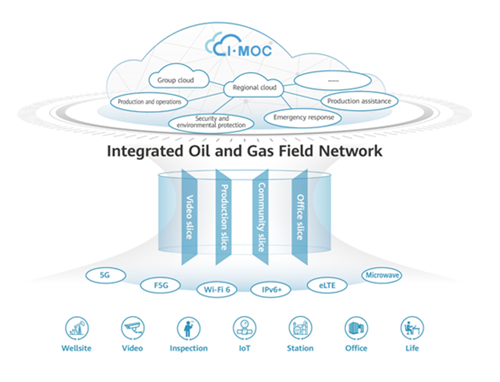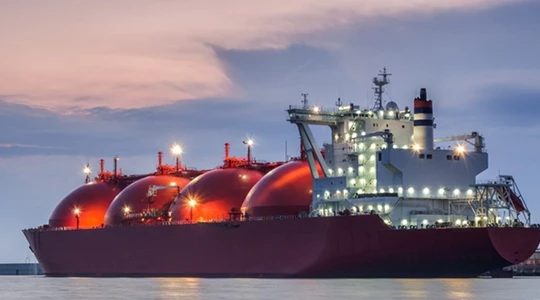Integrated oil & gas field network solution — the foundation for smart oilfields
Oil and gas fields cover vast areas and have long transmission lines. As business expands, companies need more storage and higher production capacity, while also saving costs, improving efficiency, and ensuring safety. Intelligent technologies for oil and gas fields can help address these demands.
Li Yangming, Chief Representative of the Oil and Gas Sector, Huawei Enterprise BG, explains that digital technologies have the capacity to improve resource endowment, labor productivity, management, and decision-making, helping enterprises assure safe production and stable development.
Currently, the oil and gas industry is shifting towards unstaffed operations that are automated and centrally managed through functional platforms. The industry is also looking to become greener and diversify production. To drive this transformation, digital technologies are absolutely critical.
Integrated networks will enable collaboration and intelligence
Most oilfield network systems face long-standing issues, such as an unclear architecture, multiple layers, difficult O&M, high latency, and low reliability, slowing down intelligent transformation.
In this respect, Li Yangming notes that “to achieve intelligence, we first need to optimise the network. The prerequisite for building smart oil and gas fields is to build a network system that features wide coverage, easy O&M, high bandwidth, and high stability. This is the basis for intelligent control and better decision-making.”
Without secure, reliable, intelligent, and efficient networks, building smart oil and gas fields with intensive production, centralised control, and fewer or no staff is virtually impossible. As such, an integrated network will be essential in the near future.
Huawei's Integrated Oil & Gas Field Network Solution

Huawei's integrated oil and gas field network uses key technologies, such as edge computing, AI, hard pipe isolation, and IPv6+, serving as an interconnection network. It connects end sensors to edge gateways and connects to the cloud through wired and wireless backhaul technologies, enabling centralised network management and automatic O&M. The result is a secure, autonomous, and trusted network.
Typically, multiple networks coexist alongside old and new technologies during oil and gas field network construction. Since the network architecture is not unified, data and algorithm communication flows are restricted. Huawei has an in-depth understanding of the oil and gas industry and is a leader in network technologies, such as industrial PON, Wi-Fi 6, 5G, IPv6, SDN, Liquid-OTN, and AI O&M. Based on these insights, Huawei has built a comprehensive network solution with full-stack network technologies for oil and gas fields, which integrates the cloud, network, and edge to cover all oil and gas field service scenarios.
Oil and gas field networks face another major issue — there are too many network elements (NEs) and models built by different vendors at different times. Plus, the complex network management systems (NMSs) make manual O&M and live network management exponentially more difficult. In response, Huawei has built an O&M management platform that centralises network-wide device management and integrates third-party network devices. It displays the status, link quality, and operation efficiency of the entire network from wellheads to oil and gas production plants, supporting daily oil and gas field operations and offering digital views. It helps operators forecast daily operation efficiency and optimize the entire production process, creating business value.
The integrated oil and gas field network is not a simple single-service network, but a central network for architecture, experience, and O&M. Huawei's unique industrial PON network slicing technology alongside IP Flex-E and optical network NHP enable hard isolation across all services on the oilfield production, video, office, and community networks, assuring security. Plus, enterprises save on investments costs, since all four networks are carried one physical network. Ultimately, the Integrated Oil & Gas Field Network Solution is a security foundation for intelligent oil and gas development.
Oil and gas enterprises are becoming more digital, which speeds up their transformation. Huawei's integrated oil and gas field network solution, driven by data and intelligent technologies, is expected to be promoted and applied to more oilfield enterprises worldwide.
Li Yangming notes that "Huawei needs to focus on the application of intelligent technologies as it reconstructs oil and gas field network facilities. With cloud and AI, Huawei hopes to work with partners to deliver smart station and smart platform solutions for oil and gas enterprises, making the oil and gas industry more digital and intelligent."
KEEPING THE ENERGY INDUSTRY CONNECTED
Subscribe to our newsletter and get the best of Energy Connects directly to your inbox each week.
By subscribing, you agree to the processing of your personal data by dmg events as described in the Privacy Policy.















